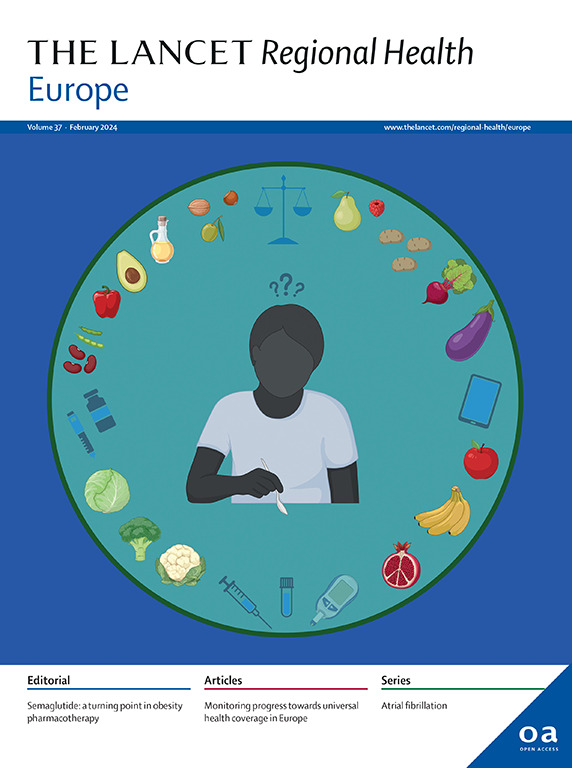德国TIM-HF2试验中心衰患者的乡村性、旅行距离和远程患者管理的有效性:一项开放标签随机对照试验的预先指定分析
IF 13
Q1 HEALTH CARE SCIENCES & SERVICES
引用次数: 0
摘要
尽管农村地区心力衰竭(HF)负担较高,但与城市地区相比,专门的心力衰竭护理的可及性有限。本研究旨在评估远程患者管理(RPM)对心力衰竭患者临床结果的影响,考虑三种不同的地理空间决定因素。方法:这是对TIM-HF2(心衰远程医疗介入管理II)开放标签随机试验的预先指定分析,该试验比较了随机化前12个月内心衰住院患者RPM干预与常规护理的效果。患者按1:1的比例随机分配到RPM或常规护理。此外,根据心脏病专家的位置,随机化采用农村和城市地区2:1的医疗保健比例。主要终点是由于全因死亡或计划外心血管住院而损失的天数百分比,次要终点是全因和心血管死亡率。目前的调查集中在假设影响RPM干预有效性的三个关键因素上:心脏病专家的位置(农村vs城市),患者的居住地(农村vs城市),以及这两个地点之间的旅行距离。TIM-HF2试验已在ClinicalTrials.gov注册(NCT01878630),并已完成。TIM-HF2试验于2013年8月13日至2018年5月18日进行。在本分析中,主要试验的所有1538例患者被纳入;其中915人(59%)由农村心脏病专家治疗,623人(41%)由城市心脏病专家治疗。生活在农村的患者的中位出行距离高于生活在城市地区的患者:14.1公里(四分位数4.3,29.1)比6.5公里(四分位数3.9,13.8)。无论心脏病专家的位置如何,RPM干预在主要终点上都显示出相当的降低:农村的比率为0.82 (95% CI 0.62-1.08),城市的比率为0.78 (0.55-1.09);居住地:农村为0.74(0.55-0.99),城市为0.89(0.65-1.22)。RPM干预在增加行走距离时表现出更强的有效性,距离每增加一倍,风险降低13% (2.2%-23.3%;p-相互作用= 0.021)。这些距离依赖效应在两个次要终点均一致,即全因(风险比0.75 [0.63-0.90];p交互作用= 0.002)和心血管死亡率(0.77 [0.62-0.96];p-相互作用= 0.019)。在TIM-HF2试验中,无论心脏病专家的位置如何,InterpretationRPM都同样有效。离心脏病专家更远的患者从RPM干预中获益最多。这些研究结果表明,应更加重视为远离专门心衰护理的患者提供RPM服务。德国联邦教育和研究部资助。本文章由计算机程序翻译,如有差异,请以英文原文为准。
Rurality, travel distance, and effectiveness of remote patient management in patients with heart failure in the TIM-HF2 trial in Germany: a pre-specified analysis of an open-label, randomised controlled trial
Background
Despite the higher burden of heart failure (HF) in rural areas, the accessibility of specialised HF care is limited when compared to urban areas. This study aimed to evaluate the impact of remote patient management (RPM) on clinical outcomes in heart failure patients, considering three different geospatial determinants.
Methods
This was a pre-specified analysis of the TIM-HF2 (Telemedical Interventional Management in Heart Failure II) open-label, randomised trial, which compared the effects of an RPM intervention with care as usual in patients with HF hospitalisation within the last 12 months before randomisation. Patients were randomised in a 1:1 ratio to RPM or usual care. Additionally, randomisation employed a 2:1 ratio between rural and urban areas of medical care based on the location of the cardiologist. The primary endpoint was percentage of days lost due to all-cause death or unplanned cardiovascular hospitalisation, the secondary endpoints were all-cause and cardiovascular mortality. The current investigation focused on three key factors hypothesised to influence the effectiveness of the RPM intervention: the location of the cardiologist (rural vs. urban), the patient's place of residence (rural vs. urban), and the travel distance between these two locations. The TIM-HF2 trial was registered at ClinicalTrials.gov (NCT01878630) and has been completed.
Findings
The TIM-HF2 trial was performed between August 13, 2013, and May 18, 2018. In the present analysis, all 1538 patients from the main trial were included; 915 (59%) of these were treated by a rural cardiologist, while 623 (41%) were treated by an urban cardiologist. The median travel distance was higher for patients living in rural than for those living in urban areas: 14.1 km (quartiles 4.3, 29.1) vs. 6.5 km (3.9, 13.8). The RPM intervention demonstrated a comparable reduction in the primary endpoint, irrespective of cardiologist location: rate ratio 0.82 (95% CI 0.62–1.08) for rural vs. 0.78 (0.55–1.09) for urban; or place of residence: 0.74 (0.55–0.99) for rural vs. 0.89 (0.65–1.22) for urban. The RPM intervention exhibited enhanced effectiveness at increasing travel distances, with a 13% risk reduction for each doubling of distance (2.2%–23.3%; p-interaction = 0.021). These distance-dependent effects were consistent for both secondary endpoints, i.e., all-cause (hazard ratio 0.75 [0.63–0.90]; p-interaction = 0.002) and cardiovascular mortality (0.77 [0.62–0.96]; p-interaction = 0.019).
Interpretation
RPM, as deployed in the TIM-HF2 trial, was equally effective irrespective of the cardiologist’s location. Patients living further from their cardiologist benefited the most from the RPM intervention. These findings suggest that greater emphasis should be placed on facilitating access to RPM for patients residing farther from specialized HF care.
Funding
Supported by the German Federal Ministry of Education and Research.
求助全文
通过发布文献求助,成功后即可免费获取论文全文。
去求助
来源期刊

Lancet Regional Health-Europe
Multiple-
CiteScore
19.90
自引率
1.40%
发文量
260
审稿时长
9 weeks
期刊介绍:
The Lancet Regional Health – Europe, a gold open access journal, is part of The Lancet's global effort to promote healthcare quality and accessibility worldwide. It focuses on advancing clinical practice and health policy in the European region to enhance health outcomes. The journal publishes high-quality original research advocating changes in clinical practice and health policy. It also includes reviews, commentaries, and opinion pieces on regional health topics, such as infection and disease prevention, healthy aging, and reducing health disparities.
 求助内容:
求助内容: 应助结果提醒方式:
应助结果提醒方式:


